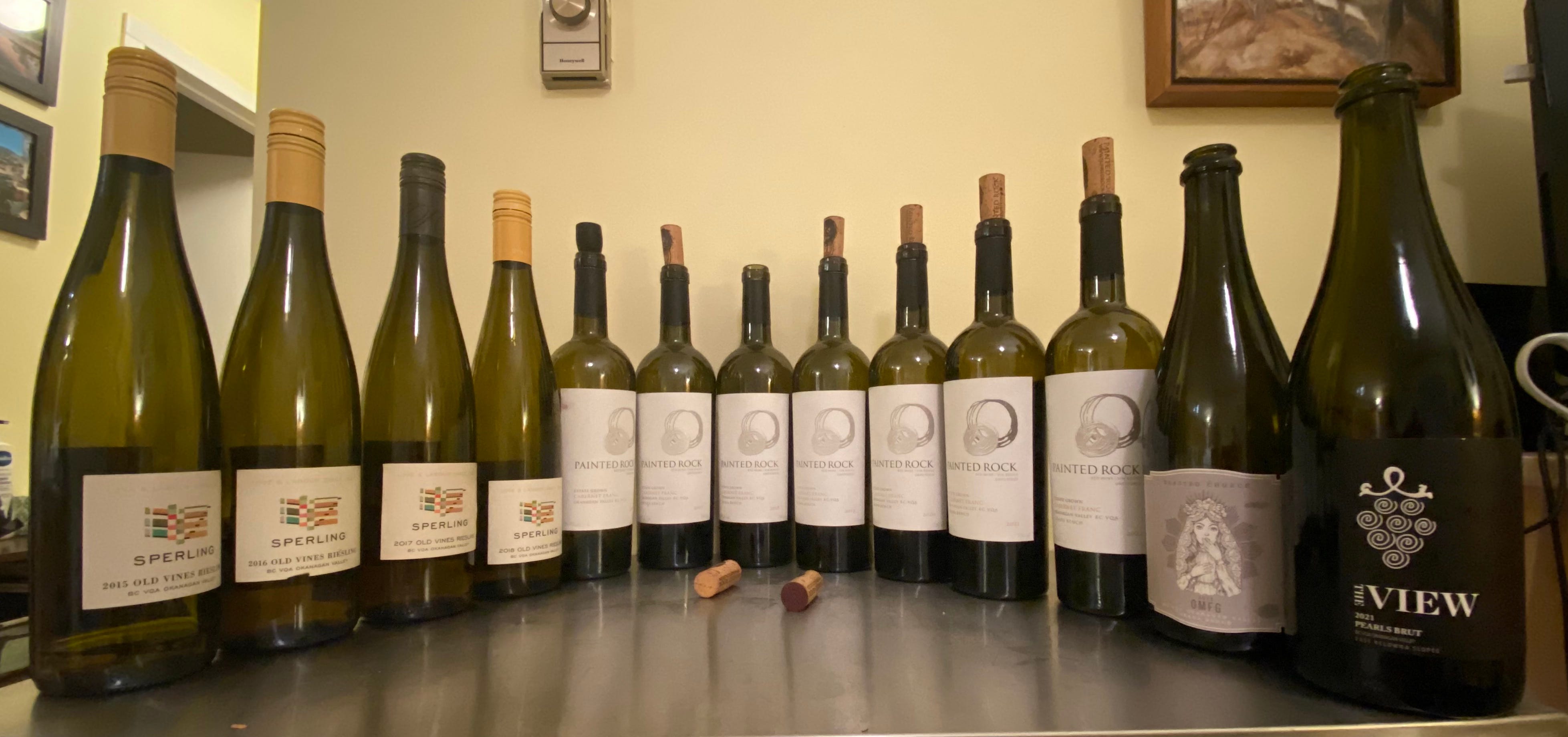I just had a significant birthday recently. I had not been looking forward to it but I have learned that distracting myself from that reality was not only possible, but it also made the day itself a lot more fun as well. Instead of a normal birthday party with balloons and silly things, I hosted a double-vertical party.
Wine verticals are a lot of fun and can be appreciated by anyone. You don’t have to be a wine expert or be very experienced with wine to appreciate them. But, you will feel like a wine expert afterwards. It is a rare opportunity to cram wine knowledge.
Tasting a vertical of wine means opening multiple vintages of the same wine. For my party, I had 4 vintages of Sperling Old Vines Riesling and 7 vintages of Painted Rock Cabernet Franc. I opened all of them for my party.
Why bother going through all of the time to collect these wines (it took years) only to open them all in one shot? Great question. Thank you for asking.
Tasting a wine through multiple vintages adds another dimension that you can’t get any other way - time. Tasting courses and techniques (the 5 S’s, the tasting grid, or WSET’s Systematic approach) can’t give you a perspective where you can taste a wine through time, over many years. How are do the oldest wines compare to the youngest? How are they different or similar? What do those differences or similarities say about the wine, or the vintage, or the winemaking?
Some years were cooler, wetter, hotter, drier, or longer or shorter seasons. Maybe there were different winemakers involved? Maybe they were made in different buildings? Sadly, smoke levels have been creeping into the conversations at verticals more and more over the past few years. Every vintage has its thing and a vertical tasting should make all of those elements clear for all to experience.
I started doing small verticals tentatively when I first moved to the Okanagan Valley. It was by accident that I had forgotten I had a vintage of a Stoneboat Pinot Noir in my cellar when I bought the next year’s wine. I saved them both for another year and then opened all three for a dinner with family shortly afterwards.
That only wetted my appetite for vertical experiences. I started to purchase wines with more purpose, and sought out wines that had the potential to go for years in the cellar. This is a little easier now but back in that era (2008), BC wine didn’t really have a proven track record for being able to do that. I quickly learned that not every wine is worth saving for a vertical. If you’ve been told that the wine that you are buying “will be great in 10 years”, ask the winery if they’ve ever offered verticals of it. If the answer is no, it’s probably not worth collecting.
Clos du Soleil Winery in Keremeos was the first winery I can remember that publicly hosted complete vertical tastings of their two flagship wines. I read John Schreiner’s account of the first one and was lucky to attend one myself soon after that. I even got to organize a couple of them years later when I worked for them as their wine club manager.
Once I had enough wine saved, I decided that verticals would be my birthday tradition. For my first 39th birthday, I had 6 vintages of Hester Creek Cabernet Franc. For my second 39th birthday, it was 8 vintages of Black Hills Nota Bene. More verticals followed, and not only for my birthday. Sometimes I just couldn’t wait for a once-a-year party. I hosted or attended more featuring Painted Rock Syrah (5 vintages), Riverstone Cornerstone (7), Fairview The Bear’s Meritage (12), Tantalus Old Vines Riesling (5), Osoyoos Larose Le Grand Vin (5), and many more. Somehow, I’ve managed to experience a Road 13 Sparkling Chenin Blanc vertical twice, including a podcast on my old Wine Country BC website with Bailey Williamson, who started the sparkling Chenin program at Road 13 in 2006.
All of the verticals were all extraordinarily memorable and taught me more about wine tasting in one evening than a month’s worth of WSET classes. What makes wine a truly fantastic tasting that you really must experience for yourself.
If you’ve read my books, you’ll know that I write about wine a little differently than most wine writers. I usually rely more on metaphors, sensations, and feelings than the more technical things. This kind of tasting doesn’t really lend itself well to my metaphorical writing style because the gradations of variation between vintages are often so subtle. If a wine is going to be chatty one year, it’s going to be like that every year. This is actually something that I learned from writing about this vertical. But, I will do my best to convey as much about these wines through my notes as I can, but it might not be nearly as interesting.
Keep reading with a 7-day free trial
Subscribe to Sipster's Icons to keep reading this post and get 7 days of free access to the full post archives.




